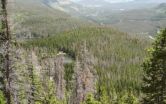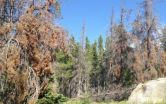(Press-News.org) On Earth Week--and in fact, every week now--trees in mountains across the western United States are dying, thanks to an infestation of bark beetles that reproduce in the trees' inner bark.
Some species of the beetles, such as the mountain pine beetle, attack and kill live trees. Others live in dead, weakened or dying hosts.
In Colorado alone, the mountain pine beetle has caused the deaths of more than 3.4 million acres of pine trees.
What effect do all these dead trees have on stream flow and water quality? Plenty, according to new research findings reported this week.
Dead trees don't drink water
"The unprecedented tree deaths caused by these beetles provided a new approach to estimating the interaction of trees with the water cycle in mountain headwaters like those of the Colorado and Platte Rivers," says hydrologist Reed Maxwell of the Colorado School of Mines.
Maxwell and colleagues have published results of their study of beetle effects on stream flows in this week's issue of the journal Nature Climate Change.
As the trees die, they stop taking up water from the soil, known as transpiration. Transpiration is the process of water movement through a plant and its evaporation from leaves, stems and flowers.
The "unused" water then becomes part of the local groundwater and leads to increased water flows in nearby streams.
The research is funded by the National Science Foundation's (NSF) Water, Sustainability and Climate (WSC) Program. WSC is part of NSF's Science, Engineering and Education for Sustainability initiative.
"Large-scale tree death due to pine beetles has many negative effects," says Tom Torgersen of NSF's Directorate for Geosciences and lead WSC program director.
"This loss of trees increases groundwater flow and water availability, seemingly a positive," Torgersen says.
"The total effect, however, of the extensive tree death and increased water flow has to be evaluated for how much of an increase, when does such an increase occur, and what's the water quality of the resulting flow?"
The answers aren't always good ones.
Green means go, red means stop, even for trees
Under normal circumstances, green trees use shallow groundwater in late summer for transpiration.
Red- and gray-phase trees--those affected by beetle infestations--stop transpiring, leading to higher water tables and greater water availability for groundwater flow to streams.
The new results show that the fraction of late-summer groundwater flows from affected watersheds is about 30 percent higher after beetles have infested an area, compared with watersheds with less severe beetle attacks.
"Water budget analysis confirms that transpiration loss resulting from beetle kill can account for the increase in groundwater contributions to streams," write Maxwell and scientists Lindsay Bearup and John McCray of the Colorado School of Mines, and David Clow of the U.S. Geological Survey, in their paper.
Dead trees create changes in water quality
"Using 'fingerprints' of different water sources, defined by the sources' water chemistry, we found that a higher fraction of late-summer streamflow in affected watersheds comes from groundwater rather than surface flows," says Bearup.
"Increases in stream flow and groundwater levels are very hard to detect because of fluctuations from changes in climate and in topography. Our approach using water chemistry allows us to 'dissect' the water in streams and better understand its source."
With millions of dead trees, adds Maxwell, "we asked: What's the potential effect if the trees stop using water? Our findings not only identify this change, but quantify how much water trees use."
An important implication of the research, Bearup says, is that the change can alter water quality.
The new results, she says, help explain earlier work by Colorado School of Mines scientists. "That research found an unexpected spike in carcinogenic disinfection by-products in late summer in water treatment plants."
Where were those water treatment plants located? In bark beetle-infested watersheds.
INFORMATION:
Earth Week: Bark beetles change Rocky Mountain stream flows, affect water quality
What happens when millions of dead trees, killed by beetles, no longer need water?
2014-04-21
ELSE PRESS RELEASES FROM THIS DATE:
Krypton-dating technique allows researchers to accurately date ancient Antarctic ice
2014-04-21
A team of scientists, funded by the National Science Foundation (NSF), has successfully used a new technique to confirm the age of a 120,000-year-old sample of Antarctic ice.
The new dating system is expected to allow scientists to identify ice that is much older, thereby reconstructing climate much farther back into Earth's history and potentially leading to an understanding of the mechanisms that cause the planet to shift into and out of ice ages.
The use of a radiometric-Krypton-dating technique on ice from Antarctica's Taylor Glacier was documented in a paper published ...
Progress made in developing nanoscale electronics
2014-04-21
Scientists are facing a number of barriers as they try to develop circuits that are microscopic in size, including how to reliably control the current that flows through a circuit that is the width of a single molecule.
Alexander Shestopalov, an assistant professor of chemical engineering at the University of Rochester, has done just that, thereby taking us one step closer to nanoscale circuitry.
"Until now, scientists have been unable to reliably direct a charge from one molecule to another," said Shestopalov. "But that's exactly what we need to do when working with ...
A gene within a gene contributes to the aggressiveness of acute myeloid leukemia
2014-04-21
COLUMBUS, Ohio – A small gene that is embedded in a larger, well-known gene is the true leukemia-promoting force usually attributed to the larger gene, according to a new study by researchers at The Ohio State University Comprehensive Cancer Center – Arthur G. James Cancer Hospital and Richard J. Solove Research Institute (OSUCCC – James).
The findings are published in the journal Science Signaling.
The larger host gene is called BAALC (pronounced "Ball C"). The smaller embedded gene is called microRNA-3151 (miR-3151). The study investigated the degree to which each ...
Simulating in tiny steps gave birth to long-sought-after method
2014-04-21
Using computer simulations to predict which drug candidates offer the greatest potential has thus far not been very reliable, because both small drug-like molecules and the amino acids of proteins vary so much in their chemistry. Uppsala researchers have now cunningly managed to develop a method that has proven to be precise, reliable and general.
The largest class of human target proteins for drugs are the so-called G-protein-coupled receptors. They are targets for about 40 per cent of all drugs on the market. These receptors are found in the cell membrane and handle ...
Lack of breeding threatens blue-footed boobies' survival
2014-04-21
Blue-footed Boobies are on the decline in the Galápagos.
A new study appearing in the journal Avian Conservation and Ecology indicates numbers of the iconic birds, known for their bright blue feet and propensity to burst into dance to attract mates, have fallen more than 50 percent in less than 20 years.
The drastic drop in population is probably due to an unexplained disappearance of sardines from the Boobies' diet, said Dave Anderson, a professor of biology at Wake Forest University and the study's principal investigator. This in turn has adult Boobies electing not ...
NASA sees wind shear affecting newborn Tropical Cyclone Jack
2014-04-21
Tropical Cyclone Jack may have hurricane-force winds today, April 21, but strong vertical wind shear is expected to weaken the storm. NASA's TRMM satellite passed overhead and saw that the bulk of the storm's rainfall was being pushed south of the center from the wind shear.
Tropical Cyclone Jack formed on Sunday, April 20, near 13.4 south and 91.1 east, and began moving to the south at 6 knots/6.9 mph/11.1 kph. Jack strengthened quickly and hours after its birth, the storm already had maximum sustained winds near 55 knots/63.2 mph/101.9 kph.
On April 21 at 0900 UTC/5 ...
Taking the pulse of mountain formation in the Andes
2014-04-21
Scientists have long been trying to understand how the Andes and other broad, high-elevation mountain ranges were formed. New research by Carmala Garzione, a professor of earth and environmental sciences at the University of Rochester, and colleagues sheds light on the mystery.
In a paper published in the latest Earth and Planetary Science Letters, Garzione explains that the Altiplano plateau in the central Andes—and most likely the entire mountain range—was formed through a series of rapid growth spurts.
"This study provides increasing evidence that the plateau formed ...
Edible flowers may inhibit chronic diseases
2014-04-21
A new study in the Journal of Food Science, published by the Institute of Food Technologists (IFT), found that common edible flowers in China are rich in phenolics and have excellent antioxidant capacity. Edible flowers, which have been used in the culinary arts in China for centuries, are receiving renewed interest. Flowers can be used as an essential ingredient in a recipe, provide seasoning to a dish, or simply be used as a garnish. Some of these flowers contain phenolics that have been correlated with anti-inflammatory activity and a reduced risk of cardiovascular disease ...
MSU physicists push new Parkinson's treatment toward clinical trials
2014-04-21
EAST LANSING, Mich. --- The most effective way to tackle debilitating diseases is to punch them at the start and keep them from growing.
Research at Michigan State University, published in the Journal of Biological Chemistry, shows that a small "molecular tweezer" keeps proteins from clumping, or aggregating, the first step of neurological disorders such as Parkinson's disease, Alzheimer's disease and Huntington's disease.
The results are pushing the promising molecule toward clinical trials and actually becoming a new drug, said Lisa Lapidus, MSU associate professor ...
The anti-inflammatory factory
2014-04-21
Russian scientists, in collaboration with their colleagues from Pittsburgh University, find how lipid mediators are produced. The relevant paper was publish in Nature Chemistry. Lipid mediators are molecules playing an important role in inflammation process. A study devoted to some of them has earned a Nobel prize in 1982.
Mitochondria are known as "cellular power plants", the organelles where oxidation of various substances leads to formation of adenosine triphosphate (ATP), a molecule universally used for storage and transportation of energy inside cells. But this is ...
LAST 30 PRESS RELEASES:
Statins significantly reduce mortality risk for adults with diabetes, regardless of cardiovascular risk
Brain immune cells may drive more damage in females than males with Alzheimer’s
Evidence-based recommendations empower clinicians to manage epilepsy in pregnancy
Fungus turns bark beetles’ defenses against them
There are new antivirals being tested for herpesviruses. Scientists now know how they work
CDI scientist, colleagues author review of global burden of fungus Candida auris
How does stroke influence speech comprehension?
B cells transiently unlock their plasticity, risking lymphoma development
Advanced AI dodel predicts spoken language outcomes in deaf children after cochlear implants
Multimodal imaging-based cerebral blood flow prediction model development in simulated microgravity
Accelerated streaming subgraph matching framework is faster, more robust, and scalable
Gestational diabetes rose every year in the US since 2016
OHSU researchers find breast cancer drug boosts leukemia treatment
Fear and medical misinformation regarding risk of progression or recurrence among patients with breast cancer
Glucagonlike peptide-1 receptor agonists and asthma risk in adolescents with obesity
Reviving dormant immunity: Millimeter waves reprogram the immunosuppressive microenvironment to potentiate immunotherapy without obvious side effects
Safety decision-making for autonomous vehicles integrating passenger physiological states by fNIRS
Fires could emit more air pollution than previously estimated
A new way to map how cells choose their fate
Numbers in our sights affect how we perceive space
SIMJ announces global collaborative book project in commemoration of its 75th anniversary
Air pollution exposure and birth weight
Obstructive sleep apnea risk and mental health conditions among older adults
How talking slows eye movements behind the wheel
The Ceramic Society of Japan’s Oxoate Ceramics Research Association launches new international book project
Heart-brain connection: international study reveals the role of the vagus nerve in keeping the heart young
Researchers identify Rb1 as a predictive biomarker for a new therapeutic strategy in some breast cancers
Survey reveals ethical gaps slowing AI adoption in pediatric surgery
Stimulant ADHD medications work differently than thought
AI overestimates how smart people are, according to HSE economists
[Press-News.org] Earth Week: Bark beetles change Rocky Mountain stream flows, affect water qualityWhat happens when millions of dead trees, killed by beetles, no longer need water?







